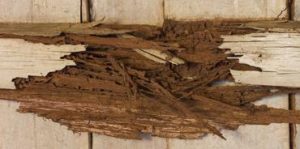Dry Rot Control and Treatment in Moreno Valley, CA
The fact is, dry rot is incredibly common near the coast. If you have dry rot, it is essential to act quickly. The longer you wait, the more damage will be done to your home’s infrastructure. To keep property damage to a minimum, call Final Exterminators. We can ensure your home is free of dry rot for good. The first and only step is to call us now for a free and honest quote.

What is Dry Rot?
Dry rot is a type of fungus known as Serpula lacrymans. Once your home is infected, the fungus can wreak havoc on all kinds of materials, including both hard and softwoods.
Dry rot works by removing the moisture from the wood, which is how the problem got its name. The fungus not only sucks out all the moisture, but it also consumes the wood, which will eventually destroy your home.
How Does Dry Rot Begin
Since dry rot is a fungus, we know that it loves moist and humid conditions. Dry rot begins when moisture gets trapped in the wood where it then cannot dry out. Moisture travels on the inside of wood, and you can have dry rot even if the wood outside appears dry.
Dry rot can also spread through masonry (even if the masonry itself remains unaffected) and other building materials. Dry rot is hard to contain at times because it likes to hide in the unlikeliest of places.
We tend to get many cases of dry rot in Southern California because of the coastal fog and ocean air. Therefore, you may be vigilant against all conditions that can lead to dry rot and the destruction it causes.
What Does Dry Rot Look Like?
You know you have dry rot when you notice discolorations on various sections of wood. Dry rot usually presents itself as a dark brown on lighter-colored wood. Dry rot can also create a square or rectangular crack, known as a cuboidal. You might even notice red dust surrounding the affected area, as well the musty odor we typically associate with mold.
If conditions are particularly humid, you may notice visible signs of orange and mushy fungus or mycelium.
On the other hand, if the affected area is painted, the dry not may not so visibly notable. To be sure, look for spots where the wood looks sunken or shriveled behind the paint.
If any wood areas in your home feel softer than normal, dry rot may be present.
What Areas Are Most Susceptible to Dry Rot?
Dry rot can appear both inside and outside your home. Decking on the exterior of your home can be problematic, as water tends to pool after a hard rain. Thus, decks and patios tend to be prone to dry rot unless coated with a rot-proof decking solution.
Other areas outside the home that may have uncommonly high instances of dry rot include lattices and trellises, as well as fencing. Again, these areas should be treated thoroughly to keep dry rot at bay.
Many homes made of stucco used to be breeding grounds for dry rot before weep screeds became heavily used. Stucco can wick moisture from the wet soil, which puts the home at risk. Weep screeds are installed at the bottom of each wall to allow moisture to drain from the walls and prevent water from entering the home’s wood framing.
IF your home is near the coast, look for leaks around windows and doors, as these areas can also be areas where dry rot tends to hide. Dry rot can also be found in your bathrooms due to pipe leaks, and in your showers and baths due to high humidity and poor circulation.
 Get Started Now. Give us a call at (800) 953 1397
Get Started Now. Give us a call at (800) 953 1397What if Dry Rot is Left to Worsen?
Dry rot should be acted upon quickly to prevent further damage. If left to get worse, the dry rot can eventually ruin the structural integrity of your home. Dry rot spreads quickly, which is why it is often characterized as a cancer of the home.
Dry rot can also attract wood consuming insects like termites. As pest control experts, we often see termites and dry rot existing simultaneously, which can cause even greater destruction to your home while cheapening its value.
Termites vs. Dry Rot
Both termites and dry rot enter your home through moist soil. However, there are differences between the two infestations so that you can identify the proper course of treatment.
Subterranean termites are tiny insects that live in colonies underneath the soil. These bugs then feed on the cellulose in the wood, leaving wood hollowed out, weak, and brittle.
The termites create tunnels to enter your home through the soil, or they will enter your home via cracks in your foundation. Once inside, the insects go to work, leaving a wake of destruction in their path.
You can usually identify termites by their droppings, by seeing the swarms of the ant-like insects themselves, or by witnessing the damage they have done.
If you can’t tell the difference and you remain unsure if you have dry rot or termites, it is important not to wait. The longer you hold off on the proper dry rot removal or termite pest control, the more you may end up paying to repair the damage that’s been done.
Contact a Dry Rot Inspection and Removal Professional in Moreno Valley
If you suspect you have dry rot in and around your home, we can provide you with a comprehensive dry rot inspection. We will search every nook and cranny of your property, particularly in areas where the fungus likes to hide. If we identify a dry rot problem, we have specialized treatments and techniques to eradicate the problem fast to save you time, money, and frustration.
Dry rot damage is irreversible, so don’t delay. Call now for a free and honest quote, and Final Exterminators can rid your home of dry rot, guaranteed.
We Do Dry Rot Treatment and Control Service in & near Moreno Valley, CA
Phone: (800) 953-1397

